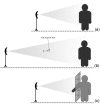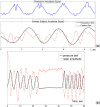Medical applications of shortwave FM radar: remote monitoring of cardiac and respiratory motion
- PMID: 20384270
- PMCID: PMC2847938
- DOI: 10.1118/1.3267038
Medical applications of shortwave FM radar: remote monitoring of cardiac and respiratory motion
Abstract
Purpose: This article introduces the use of low power continuous wave frequency modulated radar for medical applications, specifically for remote monitoring of vital signs in patients.
Methods: Gigahertz frequency radar measures the electromagnetic wave signal reflected from the surface of a human body and from tissue boundaries. Time series analysis of the measured signal provides simultaneous information on range, size, and reflective properties of multiple targets in the field of view of the radar. This information is used to extract the respiratory and cardiac rates of the patient in real time.
Results: The results from several preliminary human subject experiments are provided. The heart and respiration rate frequencies extracted from the radar signal match those measured independently for all the experiments, including a case when additional targets are simultaneously resolved in the field of view and a case when only the patient's extremity is visible to the radar antennas.
Conclusions: Micropower continuous wave FM radar is a reliable, robust, inexpensive, and harmless tool for real-time monitoring of the cardiac and respiratory rates. Additionally, it opens a range of new and exciting opportunities in diagnostic and critical care medicine. Differences between the presented approach and other types of radars used for biomedical applications are discussed.
Figures




Similar articles
-
Measurement of human heartbeat and respiration signals using phase detection radar.Rev Sci Instrum. 2007 Oct;78(10):104703. doi: 10.1063/1.2798937. Rev Sci Instrum. 2007. PMID: 17979445
-
Non-invasive respiration rate estimation using ultra-wideband distributed cognitive radar system.Conf Proc IEEE Eng Med Biol Soc. 2006;2006:920-3. doi: 10.1109/IEMBS.2006.260759. Conf Proc IEEE Eng Med Biol Soc. 2006. PMID: 17945609
-
A digital signal processor for Doppler radar sensing of vital signs.IEEE Eng Med Biol Mag. 2002 Sep-Oct;21(5):161-4. doi: 10.1109/memb.2002.1044188. IEEE Eng Med Biol Mag. 2002. PMID: 12405072 No abstract available.
-
An Overview of Signal Processing Techniques for Remote Health Monitoring Using Impulse Radio UWB Transceiver.Sensors (Basel). 2020 Apr 27;20(9):2479. doi: 10.3390/s20092479. Sensors (Basel). 2020. PMID: 32349382 Free PMC article. Review.
-
Wearable system-on-a-chip UWB radar for contact-less cardiopulmonary monitoring: present status.Annu Int Conf IEEE Eng Med Biol Soc. 2008;2008:5274-7. doi: 10.1109/IEMBS.2008.4650404. Annu Int Conf IEEE Eng Med Biol Soc. 2008. PMID: 19163907 Review.
Cited by
-
Doppler radar remote sensing of respiratory function.Front Physiol. 2023 Apr 27;14:1130478. doi: 10.3389/fphys.2023.1130478. eCollection 2023. Front Physiol. 2023. PMID: 37179837 Free PMC article. Review.
-
Sensing Systems for Respiration Monitoring: A Technical Systematic Review.Sensors (Basel). 2020 Sep 22;20(18):5446. doi: 10.3390/s20185446. Sensors (Basel). 2020. PMID: 32972028 Free PMC article.
-
Noncontact spirometry with a webcam.J Biomed Opt. 2017 May 1;22(5):57002. doi: 10.1117/1.JBO.22.5.057002. J Biomed Opt. 2017. PMID: 28514470 Free PMC article.
-
Microwave Near-Field Dynamical Tomography of Thorax at Pulmonary and Cardiovascular Activity.Diagnostics (Basel). 2023 Mar 9;13(6):1051. doi: 10.3390/diagnostics13061051. Diagnostics (Basel). 2023. PMID: 36980360 Free PMC article.
-
Emission from human skin in the sub THz frequency band.Sci Rep. 2022 Mar 18;12(1):4720. doi: 10.1038/s41598-022-08432-5. Sci Rep. 2022. PMID: 35304510 Free PMC article.
References
-
- Medical Applications of Microwave Imaging, edited by Larsen L. E. and Jacobi J. H. (IEEE, Piscataway, NJ, 1986).
-
- Haddad W. S., Trebes J. E., and Matthews D. L., “Microwave hematoma detector,” U.S. Patent No. 6,233,479 B1 (15 May 2001).
-
- Li X., Bond E. J., Van Veen B. D., and Hagness S. C., “An overview of ultrawideband microwave imaging via space-time beamforming for early-stage breast cancer detection,” IEEE Antennas Propag. Mag. IAPMEZ 47, 19–34 (2005).10.1109/MAP.2005.1436217 - DOI
-
- Staderini E. M., “UWB radars in medicine,” IEEE Aerosp. Electron. Syst. Mag. IESMEA 17(1), 13–18 (2002).10.1109/62.978359 - DOI
-
- Lohman B., Boric-Lubecke O., Lubecke V. M., Ong P. W., and Sondhi M. M., “A digital signal processor for Doppler radar sensing of vital signs,” Med. Biol. Eng. Comput. MBECDY 21, 161–164 (2002). - PubMed
MeSH terms
Grants and funding
LinkOut - more resources
Full Text Sources
Other Literature Sources
Medical

